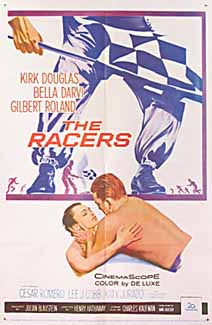
THE RACERS
US, 1955, 88 minutes, Colour.
Kirk Douglas, Bella Darvi, Gilbert Roland, Cesar Romero, Lee J. Cobb, Katy Jurado.
Directed by Henry Hathaway.
The Racers is a conventional racing car film, notable for its being made in Cinemascope in the early years of that process, thus offering a rather spectacular 1950s presentation of racing. It was to be eclipsed in the
60s by John Frankenheimer's Grand Prix.
Kirk Douglas enjoys himself as a racing driver. Bella Darvi who appeared in The Egyptian is the leading lady and Latin American actors Gilbert Roland and Cesar Romero are in the supporting cast.
The film is a film of director Henry Hathaway. Hathaway began directing in the 1930s, very successfully with such films as Lives of a Bengal Lancer as well as the first colour western, The Trail of the Lonesome
Pine. During the 1950s he made a range of action films but specialised after the war in docudrama-style films including The House on 92nd Street, 13 Rue Madeleine and Call Northside 777. He also made the psychological dramas The Dark Corner and Kiss of Death. With the coming of Cinemascope he had shown his talent with making Niagara and White Witch Doctor and in 1954-56 made Prince Valiant, Garden of Evil, The Bottom of the Bottle, Twenty-Three? Paces to Baker Street all utilising the Cinemascope format.
1. What is the appeal of racing car films? This film's use of conventions, racing sequences, the racing season, the people, the crowds, dangers and risks?
2. How successful was the presentation of the racing worlds the use of widescreen, colour, locations?
3. How well did the film communicate the world of racings the excitement, competition, speed, danger and risk?
4. The indications in the film of the type of characters involved in such a world? The compulsion to win, the self-made man, the ruthless man? How was this typified in the characters?
5. The indications from the film of the racing world, the life style, travel, hotels, passing relationships, malice?
6. The themes of planning, ambitions, sudden accidents and their effect?
7. How interesting a hero was Gino? As a man, champion, self-made, the consequences of his accident, his anger and infatuation with Nicole, helped by her, his setbacks? The sequences of the collage of his success? His becoming cruel and aggressive? The reason for his losing Nicole? His cruelty towards Carlon? His change of heart? Did the film take an optimistic view about his character?
8. Contrast Carlos with Gino. The man satisfied with the skill and the perfection of his sport? Contrast Gino with Maglio and his management and ambitions?
9. How conventional a heroine was Nicole? How real did she seem? The sequence with the dog, the hospital? Her attraction for Gino, leaving the ballet, learning from her love of him, her experience and her leaving him? The reality of the happy ending?
10. Maria and her contrast with Nicole?
11. What values were illustrated in this film? The nature of sport and heroism? Does this seem a real or an unreal world?